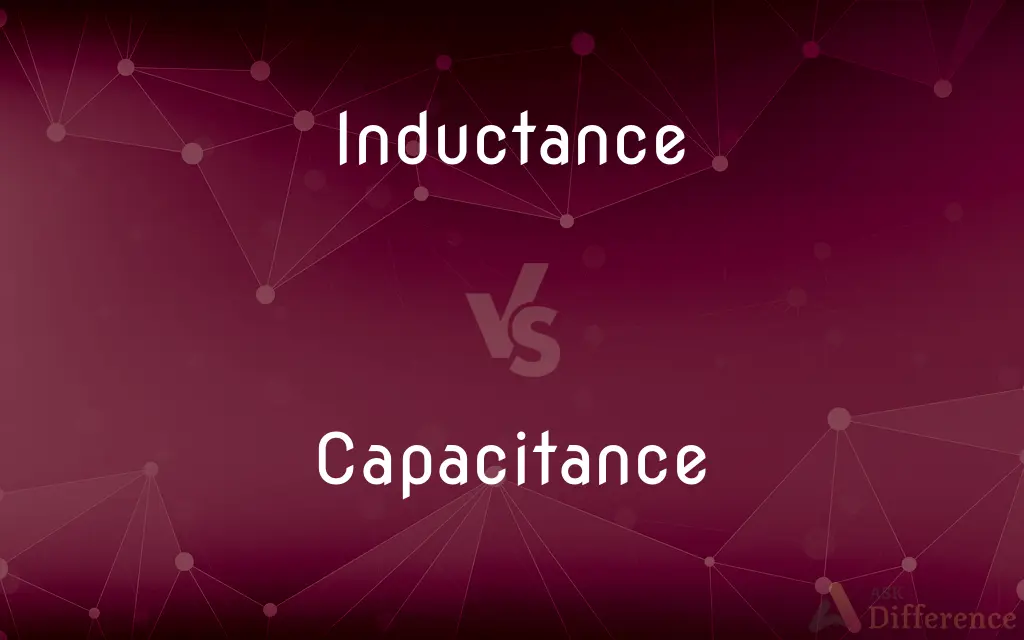Inductance vs. Capacitance — What's the Difference?
Edited by Tayyaba Rehman — By Fiza Rafique — Updated on September 25, 2023
Inductance is property of an electrical circuit that opposes changes in current. Capacitance is property of an electrical circuit that stores and releases electrical energy.

Difference Between Inductance and Capacitance
Table of Contents
ADVERTISEMENT
Key Differences
Inductance: Arises from coils or solenoids. Capacitance: Arises from capacitors.
Inductance: Opposes rapid changes in current flow. Capacitance: Stores electrical charge.
Comparison Chart
Property Origin
Coils or solenoids
Capacitors
Effect
Opposes changes in current
Stores and releases electrical energy
Key Electrical Role
Electromagnetic fields, transformers
Energy storage, filters, tuning circuits
ADVERTISEMENT
Unit of Measurement
Henries (H)
Farads (F)
Typical Application
Transformers, inductors
Energy storage, circuit filters, oscillators
Compare with Definitions
Inductance
Coil's ability to create magnetic fields.
The inductance in the transformer ensured efficient power transfer.
Capacitance
Ability to release stored energy.
Capacitance is essential for the operation of electronic devices.
Inductance
Property opposing changes in current.
The inductance of the coil slowed down the current change.
Capacitance
Property of storing electrical energy.
The capacitance of the capacitor allowed it to store charge.
Inductance
Inductance is the tendency of an electrical conductor to oppose a change in the electric current flowing through it. The flow of electric current creates a magnetic field around the conductor.
Capacitance
Capacitance is the ratio of the amount of electric charge stored on a conductor to a difference in electric potential. There are two closely related notions of capacitance: self capacitance and mutual capacitance.
Inductance
The property of an electric circuit by which an electromotive force is induced in it as the result of a changing magnetic flux.
Capacitance
The ratio of charge to potential on an electrically charged, isolated conductor.
Inductance
A circuit element, typically a conducting coil, in which electromotive force is generated by electromagnetic induction.
Capacitance
The ratio of the electric charge transferred from one to the other of a pair of conductors to the resulting potential difference between them.
Inductance
(physics) The property of an electric circuit by which a voltage is induced in it by a changing magnetic field.
The power cable itself has enough inductance to disrupt the digital signal of the video output cable, due to poor shielding.
Capacitance
The property of a circuit element that permits it to store charge.
Inductance
The quantity of the resulting electromagnetic flux divided by the current that produces it, measured in henries (SI symbol: H.)
What is the inductance of that power supply's main inductor?
Capacitance
The part of the circuit exhibiting capacitance.
Inductance
Capacity for induction; the coefficient of self-induction.
Capacitance
The property of an electric circuit or its element that permits it to store charge, defined as the ratio of stored charge to potential over that element or circuit (Q/V); SI unit: farad (F).
Inductance
(physics) a property of an electric circuit by which an electromotive force is induced in it by a variation of current
Capacitance
An element of an electrical circuit exhibiting capacitance.
Inductance
An electrical device that introduces inductance into a circuit
Capacitance
An electrical phenomenon whereby an electric charge is stored.
Capacitance
A measure of the ability of a capacitor to store electrical charge; the ratio of the charge on one plate of a capacitor to the potential difference between the plates.
Capacitance
An electrical phenomenon whereby an electric charge is stored
Capacitance
An electrical device characterized by its capacity to store an electric charge
Common Curiosities
What is capacitance in electronics?
Capacitance is the ability of a component to store and release electrical energy and is commonly associated with capacitors.
What is inductance in electrical circuits?
Inductance is a property that resists changes in current and is typically found in coils or solenoids.
What unit is used to measure capacitance?
Capacitance is measured in farads (F).
How is inductance measured?
Inductance is measured in henries (H).
Where is inductance used in electronics?
It's used in transformers, inductors, and devices that require energy storage.
What are some applications of capacitance?
Capacitance is used in energy storage, circuit filters, and tuning circuits in electronic devices.
Share Your Discovery

Previous Comparison
Colosseum vs. Stadium
Next Comparison
Engage vs. InterestAuthor Spotlight
Written by
Fiza RafiqueFiza Rafique is a skilled content writer at AskDifference.com, where she meticulously refines and enhances written pieces. Drawing from her vast editorial expertise, Fiza ensures clarity, accuracy, and precision in every article. Passionate about language, she continually seeks to elevate the quality of content for readers worldwide.
Edited by
Tayyaba RehmanTayyaba Rehman is a distinguished writer, currently serving as a primary contributor to askdifference.com. As a researcher in semantics and etymology, Tayyaba's passion for the complexity of languages and their distinctions has found a perfect home on the platform. Tayyaba delves into the intricacies of language, distinguishing between commonly confused words and phrases, thereby providing clarity for readers worldwide.














































